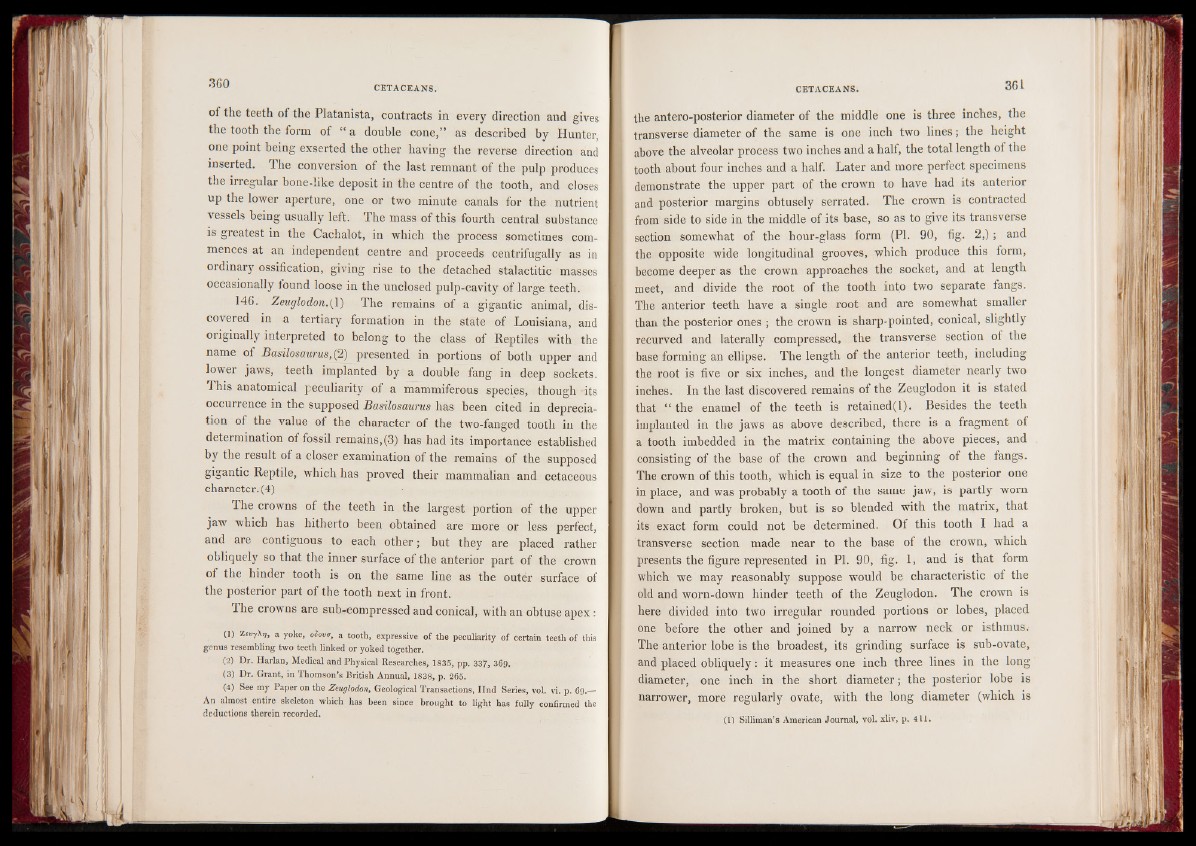
of the teeth of the Platanista, contracts in every direction and gives
the tooth the form of “ a double cone,” as described by Hunter,
one point being exserted the other having the reverse direction and
inserted. The conversion of the last remnant of the pulp produces
the irregular bone-like deposit in the centre of the tooth, and closes
up the lower aperture, one or two minute canals for the nutrient
vessels being usually left. The mass of this fourth central substance
is greatest in the Cachalot, in which the process sometimes commences
at an independent centre and proceeds centrifugally as in
ordinary ossification, giving rise to the detached stalactitic masses
occasionally tound loose in the unclosed pulp-cavity of large teeth.
146. Zeuglodon.^ 1) The remains of a gigantic animal, discovered
in a tertiary formation in the state of Louisiana, and
originally interpreted to belong to the class of Reptiles with the
name of Basilosaurus,(2) presented in portions of both upper and
lower jaws, teeth implanted by a double fang in deep sockets.
This anatomical peculiarity of a mammiferous species, though its
occurrence in the supposed Basilosaurus has been cited in depreciation
of the value of the character of the two-fanged tooth in the
determination of fossil remains, (3) has had its importance established
by the result of a closer examination of the remains of the supposed
gigantic Reptile, which has proved their mammalian and cetaceous
character. (4)
The crowns of the teeth in the largest portion of the upper
jaw which has hitherto been obtained are more or less perfect,
and are contiguous to each other; but they are placed rather
obliquely so that the inner surface of the anterior part of the crown
of the hinder tooth is on the same line as the outer surface of
the posterior part of the tooth next in front.
The crowns are sub-compressed and conical, with an obtuse apex:
(1) ZtvyXri, a yoke, oSova, a tooth, expressive of the peculiarity of certain teeth of this
genus resembling two teeth linked or yoked together.
(2) Dr. Harlan, Medical and Physical Researches, 1835, pp. 33j, 369.
(3) Dr. Grant, in Thomson’s British Annual, 1838, p. 265.
(4) See my Paper on the Zeuglodon, Geological Transactions, Ilnd Series, vol. vi. p. 69.—
An almost entire skeleton which has been since brought to light has fully confirmed the
deductions therein recorded.
the antero-posterior diameter of the middle one is three inches, the
transverse diameter of the same is one inch two lines; the height
above the alveolar process two inches and a half, the total length of the
tooth about four inches and a half. Later and more perfect specimens
demonstrate the upper part of the crown to have had its anterior
and posterior margins obtusely serrated. The crown is contracted
from side to side in the middle of its base, so as to give its transverse
section somewhat of the hour-glass form (PI. 90, fig. 2,); and
the opposite wide longitudinal grooves, which produce this form,
become deeper as the crown approaches the socket, and at length
meet, and divide the root of the tooth into two separate fangs.
The anterior teeth have a single root and are somewhat smaller
than the posterior ones ; the crown is sharp-pointed, conical, slightly
recurved and laterally compressed, the transverse section of the
base forming an ellipse. The length of the anterior teeth, including
the root is five or six inches, and the longest diameter nearly two
inches. In the last discovered remains of the Zeuglodon it is stated
that “ the enamel of the teeth is retained(l). Besides the teeth
implanted in the jaws as above described, there is a fragment of
a tooth imbedded in the matrix containing the above pieces, and
consisting of the base of the crown and beginning of the fangs.
The crown of this tooth, which is equal in size to the posterior one
in place, and was probably a tooth of the same jaw, is partly worn
down and partly broken, but is so blended with the matrix, that
its exact form could not be determined. Of this tooth I had a
transverse section made near to the base of the crown, which
presents the figure represented in PL 90, fig. 1, and is that form
which we may reasonably suppose would be characteristic of the
old and worn-down hinder teeth of the Zeuglodon. The crown is
here divided into two irregular rounded portions or lobes, placed
one before the other and joined by a narrow neck or isthmus.-
The anterior lobe is the broadest, its grinding surface is sub-ovate,
and placed obliquely: it measures one inch three lines in the long
diameter, one inch in the short diameter; the posterior lobe is
narrower, more regularly ovate, with the long diameter (which is
(D Silliman’s American Journal, vol. xliv, p. 411.